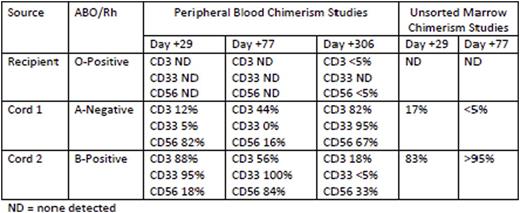Abstract
Background: Most adult patients are transplanted with two cord units to enhance engraftment after stem cell transplantation. Previous reports have demonstrated that one cord blood unit becomes dominant in the recipient and the other unit regresses. Complete chimerism with the dominant unit is achieved in >90% of patients by day +100 after transplantation. We report a case of a patient who initially demonstrated engraftment with one cord blood unit, but months later was found to be engrafted with the other unit.
A 30 year old man underwent dual cord blood transplantation for Acute Myeloid Leukemia in June 2015. The cords had identical HLA types and were both 6/10 match to the patient. During his recovery, he experienced engraftment syndrome, mild sinusoidal obstruction syndrome, Enterococcus bacteremia, and prolonged count recovery. A bone marrow biopsy done on day +77 demonstrated no evidence of disease; chimerism studies demonstrated 95% donor cells (CD3: 44% cord 1, 56% cord 2; CD33: 100% cord 2; CD56: 16% cord 1, 84% cord 2, see table). He was noted to have converted his blood type from his original O-Positive to B-Positive. He returned to his home and was not seen at our institution for several months. When he returned for follow-up on day +244, he was found to have a blood type of A-Negative. Testing with a new specimen confirmed this finding. Chimerism studies were performed to evaluate the status of the two donors in his peripheral blood on day +306.
Methods: A PCR-based STR assay was done on peripheral blood or bone marrow using the PromegaPowerPlex 16 HS System. The WBC populations were manipulated to create sub-populations enriched for CD3, CD33, and CD56, respectively.
Results: No significant recipient DNA was found in any of the specimens. On day +29, Cord 1 dominated in the CD56 cell population, but Cord 2 dominated in the CD3 and CD33 populations. On day +77, Cord 2 dominated in all cell populations, but Cord 1 still represented nearly half (44%) of CD3 cells. On day +306, Cord 1 dominated all cell populations.
Conclusion: The change in the patient's blood type is consistent with reversal of the dominance of the cord blood units received by this patient. Only one other case of this sort of reversal has been reported. This is not consistent with previously published data that the cord unit with higher CD3 chimerism as early as day +14 becomes the long-term engrafting unit.
No relevant conflicts of interest to declare.
Author notes
Asterisk with author names denotes non-ASH members.


This feature is available to Subscribers Only
Sign In or Create an Account Close Modal